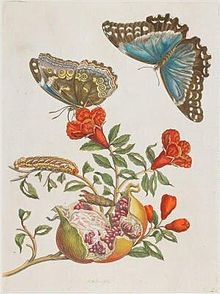Joseph Mulder: Difference between revisions
typo |
→Biography: tweak a bit |
||
| Line 12: | Line 12: | ||
Mulder's etchings are actively collected today.<ref>{{Cite web | title = Prints: Natural History - Merian M.S. | publisher = Sanderus Antiquariaat | date = 2011 | url = http://www.sanderusmaps.com/en/our-catalogue/1/prints/natural-history/merian-m.s./ | accessdate = September 13, 2011}}</ref> |
Mulder's etchings are actively collected today.<ref>{{Cite web | title = Prints: Natural History - Merian M.S. | publisher = Sanderus Antiquariaat | date = 2011 | url = http://www.sanderusmaps.com/en/our-catalogue/1/prints/natural-history/merian-m.s./ | accessdate = September 13, 2011}}</ref> |
||
==Biography== |
|||
| ⚫ | According to Houbraken he was a good etcher who had been the pupil of the Amsterdam painter [[Hendrick Bogaert]] in 1672.<ref name=Houbraken>{{languageicon|nl|Middle Dutch}} [http://www.dbnl.org/tekst/houb005groo01_01/houb005groo01_01_0396.htm Joseph Mulder Biography] in ''De groote schouburgh der Nederlantsche konstschilders en schilderessen'' (1718) by [[Arnold Houbraken]], courtesy of the [[Digital library for Dutch literature]]</ref> Mulder claimed to have played a similar prank on a baby as [[Adriaen Brouwer]] had done: after a baby, who he had been rocking on his lap, soiled him (the diaper slipped off), he laid it on the floor and defecated on |
||
| ⚫ | According to art historian [[Arnold Houbraken]], he was a good etcher who had been the pupil of the Amsterdam painter [[Hendrick Bogaert]] in 1672.<ref name=Houbraken>{{languageicon|nl|Middle Dutch}} [http://www.dbnl.org/tekst/houb005groo01_01/houb005groo01_01_0396.htm Joseph Mulder Biography] in ''De groote schouburgh der Nederlantsche konstschilders en schilderessen'' (1718) by [[Arnold Houbraken]], courtesy of the [[Digital library for Dutch literature]]</ref> Houbraken reported that Mulder claimed to have played a similar prank on a baby as [[Adriaen Brouwer]] had done: after a baby, who he had been rocking on his lap, soiled him (the diaper slipped off), he laid it on the floor and defecated on the baby. At that moment the baby's mother walked in and asked what he was doing; he replied, "het kind heeft my bescheeten, en ik beschyt het weer, dus beschyten wy malkander" ("the child shat on me, and now I shat on it, and so we're shitting on each other").<ref name=Houbraken/> |
||
| ⚫ | According to the [[Netherlands Institute for Art History]], he was an engraver and printmaker who had been a pupil of |
||
| ⚫ | According to the [[Netherlands Institute for Art History]], he was an engraver and printmaker who had been a pupil of Bogaert and also followed [[Romeyn de Hooghe]].<ref name=Netherlands Institute of Art History>[http://www.rkd.nl/rkddb/dispatcher.aspx?action=search&database=ChoiceArtists&search=priref=92183 Joseph Mulder] in the [[RKD]]</ref> |
||
==References== |
==References== |
||
Revision as of 06:10, 18 September 2011


]]
Joseph Mulder (1658, Amsterdam – ca.1728, Amsterdam), was a Dutch Golden Age printmaker, known as a "renowned engraver".[1]
An engraving by Mulder illustrates the title page of the 1700 edition, published in Leiden, of Dialogue Concerning the Two Chief World Systems by Galileo.[2] This engraving shows Aristotle, Ptolemy and Copernicus. Mulder worked abroad as well, and produced an engraving of Vienna from a bird's-eye view, in nine prints each measuring one by two feet.[3]
Along with Pieter Sluyter, he did many of the etchings for the classic book Insects of Surinam (Metamorphosis Insectorum Surinamensium) based on field drawings done by Maria Sibylla Merian.[4] This book, published in 1726, has been described as "magnificent"[5] and included early scientific study of the metamorphosis of caterpillars into butterflies.
The book Figures de la Bible a La Haye, published in 1728 in The Hague, has an etching by Mulder portraying Adam and Eve as "happy, childlike lovers" with Genesis 2:25 inscribed in six languages: German, Dutch, Hebrew, Latin, English and French. The English translation is "Adam and Eve were both naked and were not ashamed."[6]
Mulder's etchings are actively collected today.[7]
According to art historian Arnold Houbraken, he was a good etcher who had been the pupil of the Amsterdam painter Hendrick Bogaert in 1672.[8] Houbraken reported that Mulder claimed to have played a similar prank on a baby as Adriaen Brouwer had done: after a baby, who he had been rocking on his lap, soiled him (the diaper slipped off), he laid it on the floor and defecated on the baby. At that moment the baby's mother walked in and asked what he was doing; he replied, "het kind heeft my bescheeten, en ik beschyt het weer, dus beschyten wy malkander" ("the child shat on me, and now I shat on it, and so we're shitting on each other").[8]
According to the Netherlands Institute for Art History, he was an engraver and printmaker who had been a pupil of Bogaert and also followed Romeyn de Hooghe.Cite error: The <ref> tag has too many names (see the help page).
References
- ^ Reitsma, Ella (2008). Maria Sibylla Merian & daughters: women of art and science. Amsterdam: Rembrandt House Museum. ISBN 9780892369386.
- ^ Patrick, James (2007). Renaissance and Reformation. Marshall Cavendish. p. 60. ISBN 9780761476511.
- ^ Bermann, Moritz (1880). Alt- und Neu-Wien: Geschichte der Kaiserstadt und ihrer Umgebungen. Seit dem Entstehen bis auf den heutigen Tag und in allen Beziehungen zur gesammten Monarchie, Volumes 1-2. A. Hartleben. p. 979.
- ^ Wettengl, Kurt (1998). Maria Sibylla Merian, 1647-1717: artist and naturalist. Verlag Gerd Hatje.
- ^ Blunt, Wilfrid (1950). The art of botanical illustration: an illustrated history. Courier Dover Publications. p. 128. ISBN 9780486272658.
{{cite book}}: Unknown parameter|coauthors=ignored (|author=suggested) (help) - ^ McColley, Diane Kelsey (1993). A gust for paradise: Milton's Eden and the visual arts. University of Illinois Press. p. 97. ISBN 9780252018282.
- ^ "Prints: Natural History - Merian M.S." Sanderus Antiquariaat. 2011. Retrieved September 13, 2011.
- ^ a b Template:Languageicon Joseph Mulder Biography in De groote schouburgh der Nederlantsche konstschilders en schilderessen (1718) by Arnold Houbraken, courtesy of the Digital library for Dutch literature
